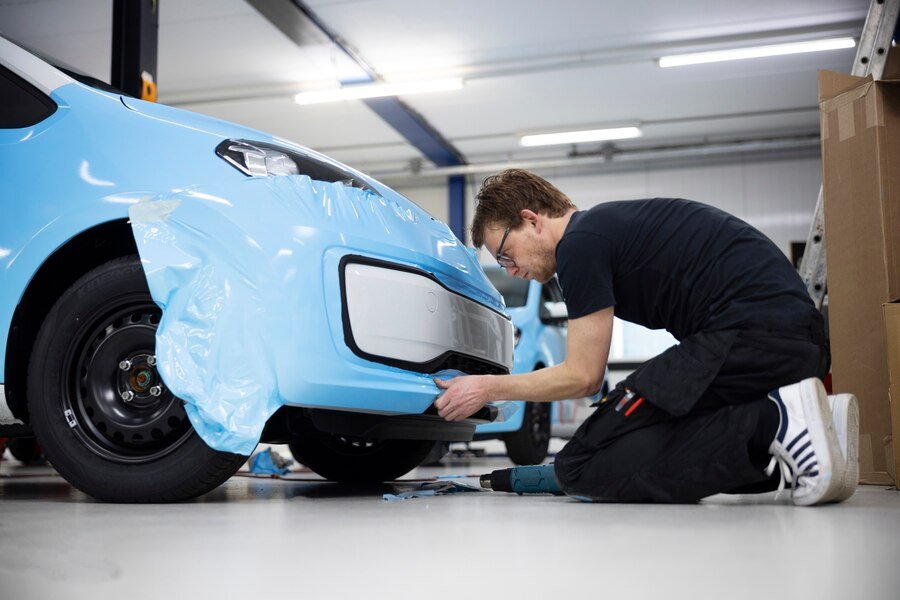Business
Car Body Maintenance: The Ultimate Guide to Keep Your Ride Shiny and New
Car Body Maintenance Ever looked at your car and thought it lost some of its original charm?

Ever looked at your car and thought it lost some of its original charm? Car body maintenance isn’t just about keeping your ride looking good; it’s about protecting your investment and ensuring your car stands the test of time. This guide will take you through everything you need to know to maintain your car’s body, from regular cleaning to dealing with scratches and rust.
Understanding Car Body Basics
To properly care for your car, it’s essential to understand its anatomy. The car body consists of several key components: the frame, panels, windows, and trim. Each part plays a vital role in the car’s overall look and functionality.
Common Materials Used
Modern cars are made from a variety of materials, including steel, aluminum, and plastic composites. Knowing what your car is made of can help you choose the right cleaning products and maintenance techniques.
How Often Should You Wash Your Car?
How often you should wash your car depends on several factors, such as where you live and how often you drive. A good rule of thumb is to wash your car every two weeks to prevent dirt buildup and damage to the paint.
Choosing the Right Cleaning Products
Not all cleaning products are created equal. Use products specifically designed for cars, as household cleaners can damage the paint and finish.
Proper Washing Techniques
Start by rinsing your car to remove loose dirt. Use a soft sponge or mitt and a bucket of soapy water to gently wash the surface. Rinse thoroughly and dry with a microfiber towel to prevent water spots.
Removing Stubborn Stains
Stubborn stains like tar or bug splatter can be tough to remove. Use a specialized cleaner and a bit of elbow grease to tackle these spots without damaging your paint.
Handling Bird Droppings and Tree Sap
Bird droppings and tree sap are highly acidic and can damage your car’s paint if not removed promptly. Use a dedicated remover or soak a cloth in warm water and place it over the area to soften the residue before wiping it away.
Why Wax Your Car?
Waxing adds a protective layer to your car’s paint, making it easier to clean and protecting it from the elements. It also gives your car a beautiful, shiny finish.
Steps to Proper Waxing
Apply a small amount of wax to a foam applicator pad and spread it evenly over the car’s surface in a circular motion. Let it dry to a haze, then buff it off with a clean microfiber towel.
The Benefits of Polishing
Polishing removes minor scratches and swirl marks, restoring your car’s paint to its original luster. It’s best done before waxing for maximum effect.
Types of Paint Protection
From traditional wax to modern ceramic coatings, there are various ways to protect your car’s paint. Each offers different levels of protection and durability.
How to Apply Paint Sealant
Paint sealant provides long-lasting protection and a high-gloss finish. Apply it in a similar manner to wax, but follow the specific instructions on the product for the best results.
Identifying Different Types of Scratches
Not all scratches are the same. Some affect only the clear coat, while others go deeper into the paint. Identifying the type of scratch helps determine the best repair method.
DIY Scratch Repairs
For minor scratches, you can use a touch-up pen or scratch repair kit. Clean the area, apply the product, and polish it smooth.
When to Seek Professional Help
Deeper scratches and chips might require professional attention. A body shop can match your car’s paint perfectly and ensure a seamless repair.
Causes of Rust
Rust occurs when metal is exposed to moisture and oxygen, leading to oxidation. Road salt, rain, and humidity can accelerate this process.
Preventative Measures
Regularly washing your car, especially the undercarriage, can help prevent rust. Applying a rust-proofing spray or coating can also protect vulnerable areas.
Treating Existing Rust
If rust has already set in, it’s crucial to address it quickly. Sand down the affected area, apply a rust converter, and repaint it to stop the spread.
Cleaning and Protecting Trim
Plastic and rubber trim can fade and crack over time. Use a trim cleaner and protectant to keep these areas looking new.
Keeping Windows and Mirrors Clear
Clean windows and mirrors not only look good but also improve visibility. Use a glass cleaner and a microfiber cloth for a streak-free finish.
Effects of Sun Exposure
The sun’s UV rays can fade your car’s paint and cause the interior to deteriorate. Parking in the shade or using a car cover can help protect your vehicle.
Shielding Your Car from Rain and Snow
Moisture from rain and snow can lead to rust and other damage. Regular waxing and using a waterproof car cover can keep your car safe from the elements.
Importance of a Clean Interior
A clean interior isn’t just about aesthetics; it’s also about comfort and hygiene. Regular vacuuming and wiping down surfaces can keep your car’s interior in top shape.
Tips for Cleaning Different Surfaces
Different materials require different cleaning methods. Use leather cleaner for seats, a fabric cleaner for upholstery, and a gentle cleaner for the dashboard and other hard surfaces.
Benefits of Using Car Covers
Car covers provide excellent protection from dust, dirt, and the elements. They’re especially useful if you don’t have a garage.
Choosing the Right Cover for Your Car
Select a cover that fits your car snugly and is made from breathable material to prevent moisture buildup.
Preparing Your Car for Summer
Summer heat can be tough on your car. Check your coolant levels, ensure your air conditioning is working, and consider applying a UV protectant to your interior surfaces.
Winter Maintenance Tips
Winter brings challenges like road salt and ice. Wash your car regularly, pay extra attention to the undercarriage, and consider using winter tires for better traction.
When to DIY
Many maintenance tasks, like washing and waxing, can be done at home with the right tools and products. DIY can save you money and give you a sense of satisfaction.
Benefits of Professional Services

For more complex tasks, like deep scratch repair or rust treatment, professional services offer expertise and quality results that might be difficult to achieve on your own.
Conclusion
Maintaining your car’s body isn’t just about keeping it looking good; it’s about protecting your investment and ensuring your vehicle lasts for years to come. Regular cleaning, proper protection, and timely repairs can make all the difference. With a little effort and the right techniques, you can keep your car shining and in excellent condition.
FAQs
How often should I wash my car?
Ideally, you should wash your car every two weeks to prevent dirt buildup and protect the paint.
Can I use household cleaning products on my car?
It’s best to use products specifically designed for cars, as household cleaners can damage the paint and finish.
What’s the best way to remove bird droppings?
Use a dedicated remover or soak a cloth in warm water and place it over the area to soften the residue before wiping it away.
How often should I wax my car?
Waxing every three months is generally recommended to maintain a protective layer on your car’s paint.
Is it worth investing in professional detailing?
Yes, professional detailing can provide a deep clean and address issues that might be difficult to tackle on your own, ensuring your car stays in top condition.
Table of Contents
-

 Tech1 year ago
Tech1 year agoHow to Use a Temporary Number for WhatsApp
-

 Business2 years ago
Business2 years agoSepatuindonesia.com | Best Online Store in Indonesia
-

 Social Media1 year ago
Social Media1 year agoThe Best Methods to Download TikTok Videos Using SnapTik
-

 Technology1 year ago
Technology1 year agoTop High Paying Affiliate Programs
-

 Tech10 months ago
Tech10 months agoUnderstanding thejavasea.me Leaks Aio-TLP: A Comprehensive Guide
-

 FOOD12 months ago
FOOD12 months agoHow to Identify Pure Desi Ghee? Ultimate Guidelines for Purchasing Authentic Ghee Online
-

 Instagram3 years ago
Instagram3 years agoFree Instagram Auto Follower Without Login
-

 Instagram3 years ago
Instagram3 years agoFree Instagram Follower Without Login




















